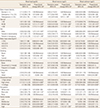1. Chowdhury BA, Chandra RK. Biological and health implications of toxic heavy metal and essential trace element interactions. Prog Food Nutr Sci. 1987; 11:55–113.
2. Maes GE, Raeymaekers JA, Hellemans B, et al. Gene transcription reflects poor health status of resident European eel chronically exposed to environmental pollutants. Aquat Toxicol. 2013; 126:242–255.

3. Chowdhury S, Mazumder MA, Al-Attas O, et al. Heavy metals in drinking water: Occurrences, implications, and future needs in developing countries. Sci Total Environ. 2016; 569-570:476–488.

4. Landsberger S, Wu D. The impact of heavy metals from environmental tobacco smoke on indoor air quality as determined by Compton suppression neutron activation analysis. Sci Total Environ. 1995; 173-174:323–337.

5. Bosch AC, O'Neill B, Sigge GO, et al. Heavy metals in marine fish meat and consumer health: a review. J Sci Food Agric. 2016; 96:32–48.

6. Rebolledo J, Fierens S, Versporten A, et al. Human biomonitoring on heavy metals in Ath: methodological aspects. Arch Public Health. 2011; 69:10.

7. Cebi A, Kaya Y, Gungor H, et al. Trace elements, heavy metals and vitamin levels in patients with coronary artery disease. Int J Med Sci. 2011; 8:456–460.

8. Kido S. Secondary osteoporosis or secondary contributors to bone loss in fracture. Bone metabolism and heavy metals (cadmium and iron). Clin Calcium. 2013; 23:1299–1306.
9. Chisolm JJ Jr. Poisoning from heavy metals (mercury, lead, and cadmium). Pediatr Ann. 1980; 9:458–468.

10. Fukushima M, Ishizaki A, Sakamoto M, et al. On distribution of heavy metals in rice field soil in the "Itai-itai" disease epidemic district. Nihon Eiseigaku Zasshi. 1970; 24:526–535.

11. Lucchini RG, Hashim D. Tremor secondary to neurotoxic exposure: mercury, lead, solvents, pesticides. Handb Clin Neurol. 2015; 131:241–249.
12. Kim YD, Eom SY, Yim DH, et al. Environmental exposure to arsenic, lead, and cadmium in people living near Janghang copper smelter in Korea. J Korean Med Sci. 2016; 31:489–496.

14. Lim HS, Kim SK, Lee HH, et al. Comparison in adherence to osteoporosis guidelines according to bone health status in Korean adult. J Bone Metab. 2016; 23:143–148.

15. Brennan SL, Henry MJ, Wluka AE, et al. BMD in population-based adult women is associated with socioeconomic status. J Bone Miner Res. 2009; 24:809–815.

16. Myong JP, Kim HR, Choi SE, et al. Dose-related effect of urinary cotinine levels on bone mineral density among Korean females. Osteoporos Int. 2013; 24:1339–1346.

17. Akesson A, Bjellerup P, Lundh T, et al. Cadmium-induced effects on bone in a population-based study of women. Environ Health Perspect. 2006; 114:830–834.

18. Staessen JA, Roels HA, Emelianov D, et al. Environmental exposure to cadmium, forearm bone density, and risk of fractures: prospective population study. Public Health and Environmental Exposure to Cadmium (PheeCad) Study Group. Lancet. 1999; 353:1140–1144.








 PDF
PDF ePub
ePub Citation
Citation Print
Print



 XML Download
XML Download